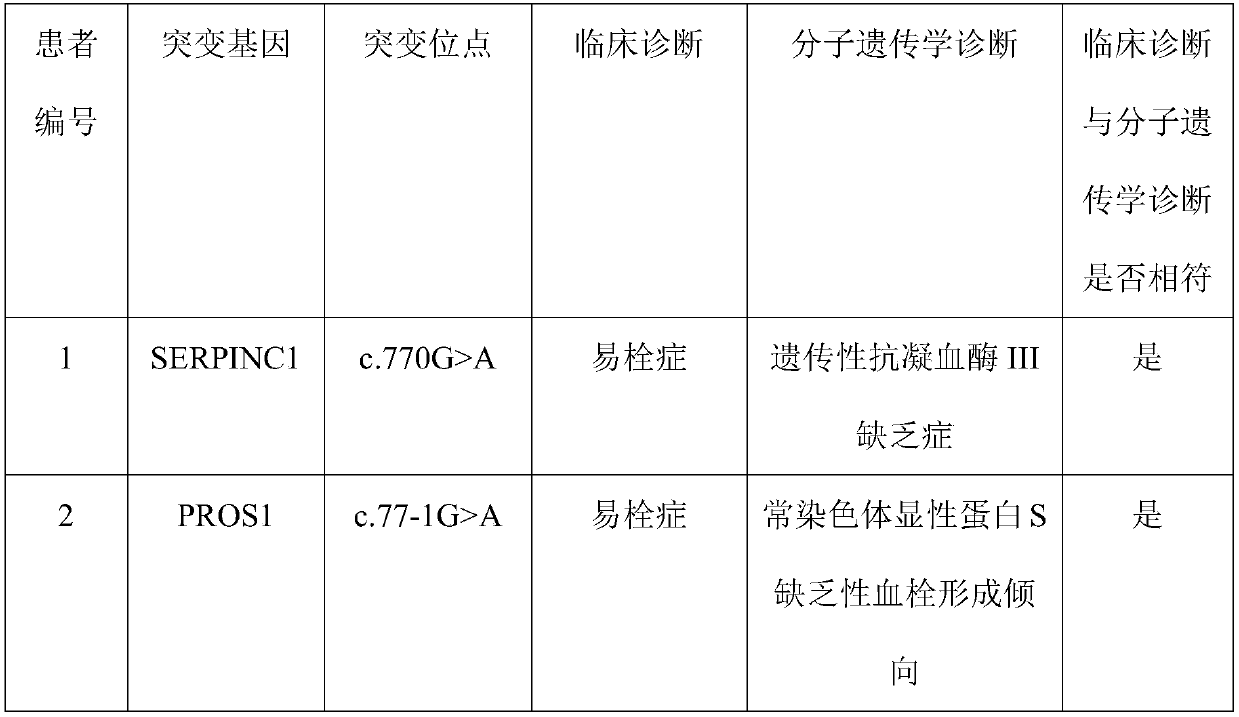Method for detecting pathogenic genes of other system diseases causing cardiovascular symptoms
A cardiovascular and symptomatic technology, applied in the direction of biochemical equipment and methods, microbial measurement/testing, etc., can solve the problems of lagging progress, low diagnostic sensitivity, and inability to clarify the genetic causes of diseases, etc., to achieve strong practicability and low cost. The effect of low and many detection sites
- Summary
- Abstract
- Description
- Claims
- Application Information
AI Technical Summary
Problems solved by technology
Method used
Image
Examples
Embodiment 1
[0058] Embodiment 1: Design and preparation of the probe set of the present invention
[0059] 1. Screening of pathogenic and / or susceptibility genes
[0060] The pathogenic and / or susceptible genes in this example are: LRP8, F13A1, F7, GCLC, GCLM, ITGB3, LGALS2, LTA, MIAT, OLR1, PSMA6, TNFSF4, POLG, SDHAF1, BCS1L, TTC19, UQCRB, UQCRQ , UQCRC2, CYC1, UQCC2, LYRM7, UQCC3, ATM, MRE11, RASA1, FOXF1, USB1, PIK3CA, STAMBP, LBR, MEF2A, LRP6, F12, ITPKC, S100A12, CD40LG, CASP3, FAM167A, HLA-A, CD40, FCGR2A , BLK, NDUFS7, NDUFS8, SURF1, PDHA1, PEX1, PEX5, PEX6, PEX2, PEX16, CTC1, NIPBL, SMC1A, SMC3, RAD21, RPS19, RPS24, RPS17, RPL35A, RPL5, RPL11, RPS7, RPS10, RPS26, RPL26 , RPL15, RPS29, TSR2, RPS28, PCCA, PCCB, GCDH, ETFA, ETFB, ETFDH, IVD, FAH, HBB, TRNT1, RBM8A, GATA1, PLA2G7, TIRAP, APP, CST3, ITM2B, PROS1, MYH9, HRG, PROC , SH2B3, JAK2, SERPINC1, PLAT, PDGFRA, C4A, HLA-B, IL10, IL23R, STAT4, TLR4, SERPIND1, MMACHC, SPINK1, CFTR, PRSS1, MPI, THBD, MPL, F9, F2, TET2, FADD, CFH ...
Embodiment 2
[0070] Embodiment 2: Composition, preparation and use of the kit of the present invention
[0071] The kit for detecting the pathogenic and / or susceptibility genes of thrombophilia described in this embodiment is to carry out the molecular genetics of the examined individual by detecting the mutations of the above-mentioned 263 pathogenic and / or susceptibility genes. Kits for diagnosis or risk prediction.
[0072]The components contained in the kit are: the probe set obtained in Example 1 (160 μL, 150 ng / μL), enrichment buffer (208 μL), hybridization buffer (800 μL), binding buffer (3.2 mL), washing Solution 1 (9mL), rinse solution 2 (45mL), NaOH solution (0.1M, 1mL), Tris-HCl buffer (1M, pH 7.5, 1.2mL), PCR reaction solution (580μL), TE buffer (800μL, 10mM Tris-HCl, 1mM EDTA, adjust the pH to 8.0, and adjust the volume to 500mL with water). Wherein each buffer composition is as follows:
[0073] (1) Enrichment buffer (per 20 μL):
[0074] Human cot-1 DNA (purchased from I...
Embodiment 3
[0120] Embodiment 3: verification of the use effect of the kit of the present invention
[0121] Utilize the kit of the present invention to detect 68 cases of samples, the results confirm that the capture rate of the target disease-causing and / or susceptibility genes is satisfactory, more than 99.83% of the original short sequences can be compared back to the reference sequence of the target region, and the target region’s The average effective sequencing data amount reaches 241.44Mb, and the average sequencing depth of the target region is 379.14X (see Table 1), which is far higher than the general genetic disease diagnosis requirements (generally 20X).
[0122] Table 1 The quality of sequencing data for pathogenic and / or susceptibility genes
[0123]
PUM
 Login to View More
Login to View More Abstract
Description
Claims
Application Information
 Login to View More
Login to View More - R&D
- Intellectual Property
- Life Sciences
- Materials
- Tech Scout
- Unparalleled Data Quality
- Higher Quality Content
- 60% Fewer Hallucinations
Browse by: Latest US Patents, China's latest patents, Technical Efficacy Thesaurus, Application Domain, Technology Topic, Popular Technical Reports.
© 2025 PatSnap. All rights reserved.Legal|Privacy policy|Modern Slavery Act Transparency Statement|Sitemap|About US| Contact US: help@patsnap.com


